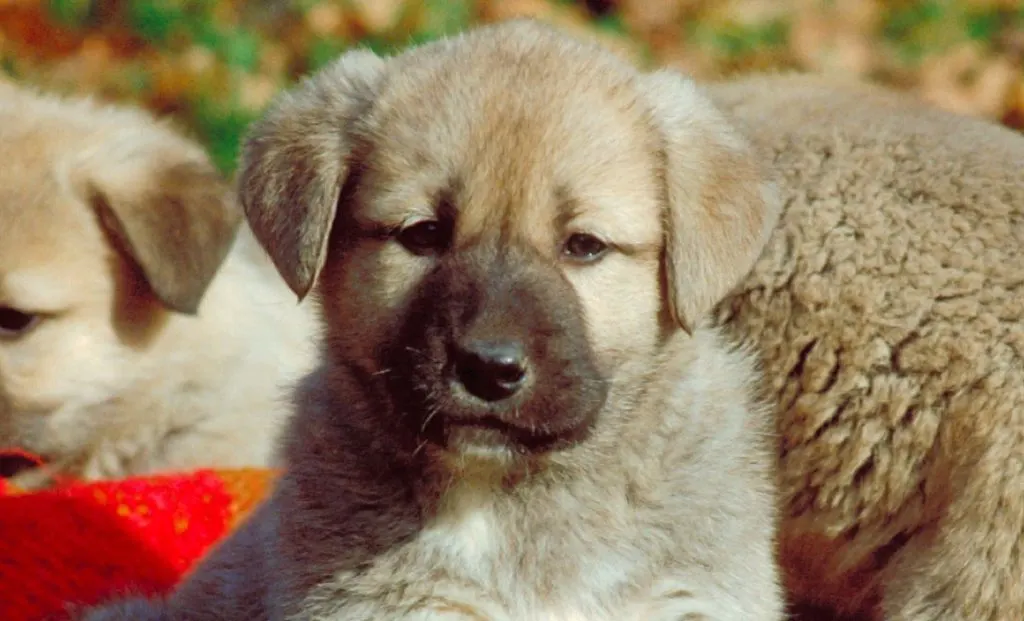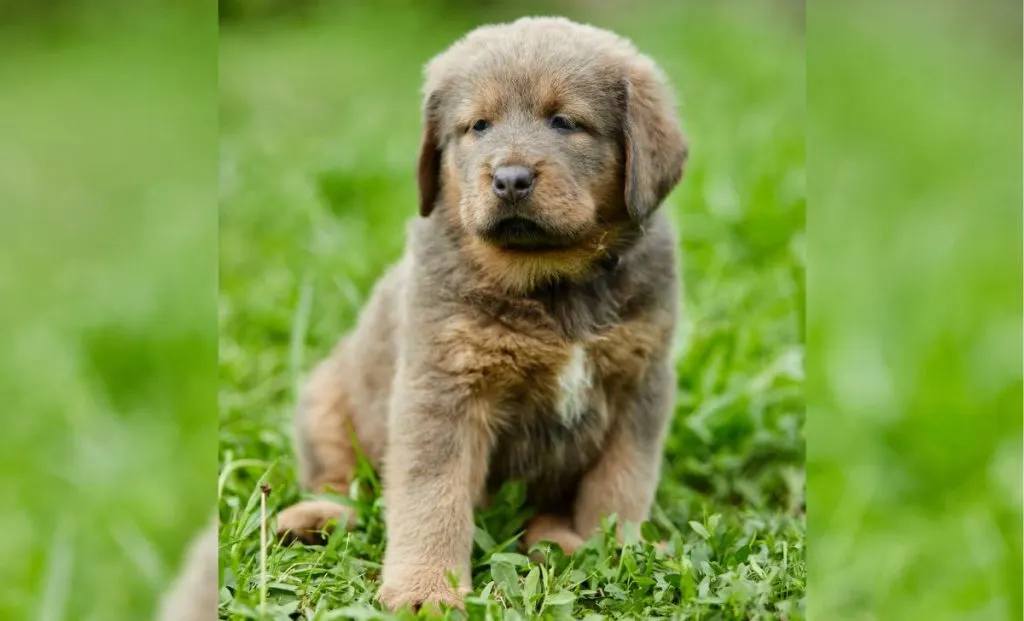Thinking about raising a gentle giant?
Begin with the essential Anatolian Shepherd growth chart, a key tool for any parent of this noble dog breed.
In this guide, we’ll explore how to use the chart effectively and share 7 expert tips to ensure your Anatolian puppy grows into a healthy and well-proportioned adult dog!
Anatolian Shepherd Growth Chart Overview
To kickstart our growth chart, here is a quick overview of how big these gentle giants actually get.
Keep in mind that the following sizes and numbers are general estimates!
Individual Anatolian Shepherd growth can vary based on factors like genetics, nutrition, and health (we will explain a bit more on that later).
| Age (Months) | Weight (kg/lbs) | Height (cm/in) |
| 1 | 4-7 / 8.8-15.4 | 30-35 / 11.8-13.8 |
| 2 | 7-12 / 15.4-26.5 | 35-40 / 13.8-15.7 |
| 3 | 12-18 / 26.5-39.7 | 38-45 / 15-17.7 |
| 4 | 15-25 / 33-55 | 42-50 / 16.5-19.7 |
| 5 | 18-30 / 39.7-66 | 45-55 / 17.7-21.7 |
| 6 | 22-35 / 48.5-77 | 48-60 / 18.9-23.6 |
| 7 | 25-40 / 55-88 | 50-63 / 19.7-24.8 |
| 8 | 28-45 / 61.7-99.2 | 52-65 / 20.5-25.6 |
| 9 | 30-50 / 66-110 | 55-68 / 21.7-26.8 |
| 10 | 32-52 / 70.5-114.6 | 57-70 / 22.4-27.6 |
| 11 | 34-55 / 75-121 | 58-72 / 22.8-28.3 |
| 12 | 35-55 / 77-121 | 60-75 / 23.6-29.5 |
It is important to note that the growth of Anatolian Shepherd dog females is often on the smaller size, when compared to their male counterparts.
Alright, now to the Anatolian puppy growth phases!
Anatolian Shepherd Puppy Growth Chart
How long does it take for an Anatolian Shepherd to grow? This is a question many new pet parents are curious about.
Well, it takes a whole year, for sure. But even after a year, your Anatolian puppy is not all grown-up as you might have thought!
Let’s take a peek at their growth stages.
0-4 Weeks

In the very first stages of life, Anatolian Shepherd puppies are tiny, incredibly vulnerable creatures completely dependent on their mother for warmth, nutrition, and protection.
Newborn Anatolian puppies usually weigh a mere 0.4 to 0.9 kg (1-2 lbs), looking almost like little bears!
It’s a critical period where the mother’s instinct to protect and nurture her offspring is strong. Interestingly, if a mother senses something is amiss with her puppies, such as a health issue, she might, though rarely, eat them.
During these first 4 weeks, Anatolian puppies undergo quite some development.
They start life blind and deaf, with their eyes and ears closed. They open them around the 10 to 14-day mark. This period also marks the beginning of their sensory exploration.
Puppies will start to wobble around, learning to walk and communicate through whines and yelps. Growth during this phase is rapid, with puppies needing their mother’s milk rich in essential nutrients to thrive.
These beloved pets will grow notably in height and weight in the coming months.
1-2 Months
As Anatolian Shepherd puppies reach 1 to 2 months of age, noticeable changes occur. They become more playful and curious about their surroundings.
By this age, they’ve typically opened their eyes and ears and have started to explore more actively.
Males and females grow at similar rates initially, but slight differences in average size and weight might begin to emerge. Males often start to show a bit more bulk.
Anatolian Shepherd puppies are growing quickly! When it comes to puppy weight gain, these little fellas are now somewhere between 4 to 7 kg (8.8-15.4 lbs).
Sibling rivalry can occur as they compete for food or attention, but it’s also a time for learning social cues.
As they interact more with their littermates, other dogs, or pets in the home, these puppies start to understand social hierarchies. They learn how to coexist peacefully with other animals and understand their place within the family unit.
Due to their teething phase kicking in, these pups may also nibble on their owners, littermates, or furniture!
At this stage, puppies are transitioning from nursing to eating puppy mush (a mix of puppy food and milk). Their senses are much sharper, helping them to become more aware of their environment.
They are already starting to exhibit boundless energy and silly gestures which makes the owners completely fall in love with them!
This period is also a crucial time to start introducing them to gentle training and socialization.
2-3 Months

By 2 to 3 months of age, Anatolian Shepherd puppies are showing more and more of their personality and individual traits. Good news is that they are now more independent from their mother. The pups are likely fully weaned, eating solid puppy food as their primary diet. Way to go!
This is a very important time for nutritional support to ensure they continue to grow into their large, giant breed size without issues like obesity or malnutrition.
They might weigh anywhere from 7 to 12 kg (15.4-26.5 lbs). Quite heavy Anatolians, compared to other breeds of dogs!
Training should definitely be underway by now. Anatolian Shepherds are intelligent and capable, but also headstrong. Therefore, early training will help in managing their protective instincts appropriately.
Socialization is also key! By now you want to have already started with introducing them to a variety of people, pets, and everyday situations.
At this stage, monitoring for any sign of health issues such as intestinal parasites is crucial. So, make sure to proceed with regular vet check-ups.
Also, think about a balanced diet, possibly supplemented with fatty acids for their coat and overall health.
Owners might consider pet insurance as a way to manage the costs of healthcare, ensuring these beloved pets receive the care they need without financial strain.
3-4 Months
During the 3-4 month period, Anatolian Shepherd puppies experience one of their most significant growth spurts. Owners often realize how quickly these pups are advancing toward their adult weight and height.
This is a time of tremendous physical and mental development, where they can almost seem to grow overnight.
Their paws, often a giveaway of their future size, start to look more proportionate as their limbs lengthen. Owners might also be surprised to find that the collar or harness purchased just a week ago suddenly feels snug, highlighting the rapid physical growth!
Even at this tender age, the protective instincts inherent in the Anatolian Shepherd breed start to surface. Puppies may begin to show an interest in watching over their home or yard. That’s a true working dog in the making!
They are also super curious and a bit mischievous. This is why the Anatolian needs to be monitored, especially if they are always outdoors.
Risks like eating a bee or a wasp, hazardous plants, or chemicals in lawn treatments are all potential dangers that puppies might encounter as their curiosity leads them to explore their environment.
The brain of a 3-4 month old Anatolian Shepherd puppy is like a sponge, making this an optimal time for training. Simple commands, crate training, and housebreaking should be well underway!
4-6 Months

As Anatolian Shepherd puppies enter the 4-6 month range, they begin to enter what can be considered their “teenage” years. Sheesh!
This period is marked by increased independence, curiosity, and sometimes stubbornness. Their growth continues at a remarkable pace. Owners must, therefore, pay careful attention to their diet to prevent health issues such as obesity — a staggering half of dog population in the United States faces weight issues.
Monitoring their intake of carbs and ensuring they receive a diet appropriate for giant breeds is critical.
This is also a time when their need for physical activity increases. Long walks become your routine, as they’re the perfect opportunities for training and bonding.
They are very playful and love to interact with their owners. Some Anatolian pups prefer squeaky toys, while others like to play with a good ol’ stick. Nevertheless, they need daily activity!
6-12 Months
From 6 to 12 months of age, Anatolian Shepherd puppies continue to grow but at a slower rate. At the first year of age, they begin to show more of their adult coat. Their physical stature starts to resemble that of an adult dog.
However, it’s important to remember that while they may start to look like adults, they are still puppies at heart and mind. Similar to other big dogs like Great Danes, Anatolians will take a long time to reach full maturity.
While they may reach their full height by their first birthday, they will continue to fill out and gain muscle until they are about 2-3 years old.
Owners should continue to provide a balanced diet to support this growth and consult with their vet about the best ways to support their development, including the potential need for pet insurance to manage health care costs effectively.
7 Tips To Help Your Anatolian Shepherd Grow Healthy
Let’s turn our attention to the practical aspects of nurturing your growing pup.
With this in mind, here are 7 tips that will not only complement the information on the chart but also ensure your Anatolian Shepherd thrives in health and vitality:
1. Balanced Diet
We all need lots of nutrients to grow, right? So do our pups!
Feeding your pup a diet tailored for large breed puppies is the perfect recipe for their growth. With this kind of diet, they get the right mix of protein, fat, and minerals.
2. Regular Exercise
Just look how we grow into fit and healthy humans when we hit the gym! Exercise is indeed the secret sauce to keeping your pup fit and happy. It’s also great for their mental well-being!
Just remember to match the activity to their age and size to keep those growing bones safe.
3. Routine Vet Visits
Regular check-ups, especially for such large dogs, help catch any sneaky health issues early. Plus, taking your pup regularly to the vet will help you have peace of mind.
It’s also a great time to brag about your puppy and maybe snag some extra petting from the vet!
4. Proper Socialization
Introducing your Anatolian puppy to new faces, furry friends, and different places makes them grow mentally.
It teaches them the art of being cool, calm, and collected no matter what the world throws at them. This is very important for such a giant breed of dog!
5. Genetic Awareness
Being in the know about your pup’s breed-specific traits and health risks is very wise. It helps you stay one step ahead and keep them as healthy as can be.
Keep this in mind if you’re considering bringing an Anatolian Shepherd into your home. It’s essential to find a reputable breeder who prioritizes pedigree and overall health.
6. Avoid Overfeeding
Keeping an eye on their food intake is another important tip. These large dogs can eat a lot! Do not fall for their puppy eyes begging for food when they just ate.
Overfeeding your Anatolian pup can lead to weight issues and put stress on their growing bodies. So, avoid it!
7. Joint Care
Under your vet’s guidance, consider supplements for joint health and healthy skin/coat.
These giant dogs are prone to skeletal problems. You want to prevent them from happening. Trust me, prevention is better than cure!
5 Factors That Affect Anatolian Shepherd Growth

As with all breeds of dogs, there are a couple of factors that greatly affect their growth. As dog owners, there are certain factors we can manage, while others are beyond our control.
Let’s see what’s up!
1. Genetics
Genetics play a crucial role in determining the size, growth rate, and potential health issues of large dog breeds.
Different breeds have specific growth patterns and potential genetic predispositions to certain conditions, impacting their overall growth and development (1).
Due to their genes, Anatolian Shepherd might grow super fast and need a little extra care to make sure their bones and joints develop right.
However, there are rare instances where genetic mutations may impede the growth of these large breeds. Dwarfism genes, resulting in shorter legs, can sometimes be present in these dogs.
Unfortunately, large breeds also live shorter than small dog breeds and this gentle giant is no exception.
2. Nutrition
Proper nutrition is essential for the healthy growth of large breed puppies. Well, the same goes for any other dog breed, but large ones really need all the fuel they can get.
However, it is important to keep it all balanced. You see, overnutrition or incorrect nutrient ratios, specifically in energy and calcium, can lead to rapid growth and associated skeletal abnormalities such as osteochondrosis and hip dysplasia.
Controlled feeding regimens that ensure balanced nutrient intake are recommended to avoid these risks (2). If you are uncertain about their diet, you should consult your vet for professional help.
Remember, just like a young athlete needs the right kind of food to grow strong and healthy, our large breed puppies need balanced meals to ensure they grow up not too fast and not too slow, but just right.
3. Physical Activity
Proper physical activity is a must for the development of Anatolian’s strong bones and muscles.
However, excessive or inappropriate exercise, especially during rapid growth phases, may increase the risk of joint disorders.
With that said, tailoring exercise to the dog’s age, breed, and individual health status is important for promoting optimal growth and preventing injuries (3).
Grab a tennis ball and head to the park, but bear in mind the risks these giant dogs may face if they overdo the play of fetch!
4. Spaying And Neutering
The timing of spaying or neutering can impact the growth and development of Anatolian Shepherds and other big dogs.
Spaying and neutering are decisions pet owners often think about. Interestingly, the timing of these procedures can influence your puppy’s growth. Doing it too early or too late can affect their development and even their health in the long run (4).
It’s a topic worth chatting about with your vet, who can give you tailored advice based on your puppy’s breed and health.
5. Health
Lastly, their overall health plays a starring role in how they grow.
Conditions like hormonal imbalances, infections, and congenital disorders can all influence growth patterns and long-term health.
Regular check-ups with the vet, staying up-to-date with vaccinations, and keeping an eye out for any unusual signs can help catch any issues early.
It’s all about being a better pet owner and giving them the best start in life so they can grow into the healthy and happy dogs they’re meant to be!
Monitoring their development with tools like the growth chart and weight calculators can be helpful for keeping track of their progress towards their adult size (5).
And hey, the Anatolian Shepherd growth chart is a good start!
References
1. Gaillard, V., Chastant, S., England, G., Forman, O., German, A., Suchodolski, J., Villaverde, C., Chavatte-Palmer, P., & Péron, F. (2022). Environmental risk factors in puppies and kittens for developing chronic disorders in adulthood: A call for research on developmental programming. Frontiers in Veterinary Science, 9. https://doi.org/10.3389/fvets.2022.944821.
2. Larsen J. Feeding large-breed puppies. Compend Contin Educ Vet. 2010 May;32(5):E1-4. PMID: 20949422.
3. Trangerud, C., Grøndalen, J., Indrebø, A., Tverdal, A., Ropstad, E., & Moe, L. (2007). A longitudinal study on growth and growth variables in dogs of four large breeds raised in domestic environments.. Journal of animal science, 85 1, 76-83 . https://doi.org/10.2527/JAS.2006-354.
4. Hart, B., (Geyer), L., Thigpen, A., & Willits, N. (2020). Assisting Decision-Making on Age of Neutering for 35 Breeds of Dogs: Associated Joint Disorders, Cancers, and Urinary Incontinence. Frontiers in Veterinary Science, 7. https://doi.org/10.3389/fvets.2020.00388.
5. Salt, C., Morris, P., German, A., Wilson, D., Lund, E., Cole, T., & Butterwick, R. (2017). Growth standard charts for monitoring bodyweight in dogs of different sizes. PLoS ONE, 12. https://doi.org/10.1371/journal.pone.0182064.

Meet Iram, a devoted veterinarian, passionate dog lover, and current Ph.D. candidate at Utrecht University in the Netherlands. Seamlessly blending her roles as a vet and content writer, Iram channels her love for dogs into heartfelt narratives.
Since childhood, Iram nurtured a dream of becoming a vet, a passion that runs deep in her family. Having now fulfilled that dream, she’s eager to share her acquired knowledge. In her writing, Iram not only explores the emotional bond between humans and their canine friends but also integrates her veterinary expertise, offering readers a holistic understanding of their beloved pets.
